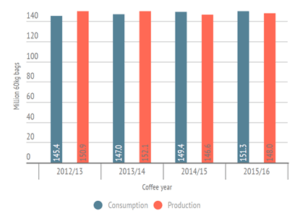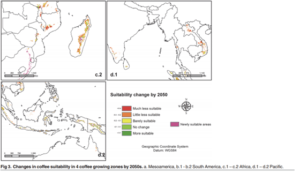Your daily jolt: Global coffee production can’t keep up with demand

How Starbucks is planning and protecting against the impending effects of climate change on the coffee industry.
54% of adults over the age of 18 in the United States drink coffee every single day.1 Statistically speaking, either you or your best friend are one of those adults. Say you walked into your local Starbucks one blustery Boston morning to find a “sold out” sign. What would you do?
While the scenario above is made up and may suggest the extreme, the strain that coffee producers, retailers, and other partners in the supply chain feel is all too real. The truth is that for the past two seasons, coffee consumption has actually outpaced production.2

Persistent annual increases in average temperature and decreases in average rainfall present challenges in keeping up with demand, as the coffee plant growth and fruiting process is highly sensitive to climate change.3 In addition to lower annual yields, research suggests that the existing lands on which 25 million coffee farmers have built their living are becoming less and less suitable to coffee growth in many regions. Over the next 30 years, climate changes are expected to continually push the “best” regions for coffee into higher altitudes and far east countries.
So what can industry players do to maintain supply for this multi-billion dollar industry? Fight to reduce climate change and protect existing farmlands? Or move to the next viable regions and develop land there? Starbucks, long a leader in both global coffee retail and green supply chain practices, is doing both, aiming to safeguard both itself and coffee players worldwide against changing conditions.
PRESERVE
Starbucks has for the past 20 years used its power in the coffee economy to drive toward sustainability. As of 2015, 99% of all Starbucks coffee is verified as “ethically sourced,” measured by social, environmental, and economic standards. Starbucks has established as a co-founder of the Sustainable Coffee Challenge the goal to make coffee the world’s first sustainable agricultural product.
Also in 2015, Starbucks announced its plan to re-purpose a 240 acre Cost Rican farm into a global farming research and development center. In the center, researchers will work to develop additional coffee varietals.4
And in May 2016, Starbucks issued the first ever U.S. “Sustainability Bond.” Starbucks has pledged to use the net proceeds of the $500 million in bonds offered to support its C.A.F.E. (Coffee & Farming Equity) Practice. Through C.A.F.E. and a set of “Farmer Support Centers” worldwide, Starbucks has lent financial and expert support to local farmers in developing and preserving their land and crops.5
CREATE
While Starbucks is investing heavily in preserving its existing supply base, it has also recognized the need to prepare its future supply (and demand) base: China. For purposes of serving increasing demand alone as coffee popularity grows in line with the growing middle class in China, it made strategic sense for Starbucks to invest in farmland in China’s Yunnan province6. But as temperature increase trends continue and point toward a shrinking of suitable lands in current coffee powerhouses like Brazil, Colombia, Guatamala, Starbucks is wise to start building up suppliers in new regions.

What else can Starbucks, and others, do to reduce the circular degradation that farming and climate change have on each other, and ultimately reduce the risk that the world coffee supply might one day shrink? Developing farmland in regions predicted to become more suitable to coffee growth in the next 30-50 years is sensible, but the capital and time required limit such opportunities to bigger organizations. Mitigation within existing farmers’ cooperatives is, even if short-term, additional step. Development of new farms takes time, so maximizing yield out of challenged farms for as long as they operate is critical.
If external forces impacting climate change don’t slow or reduce soon, mitigation measures may not be enough. Another potential solution to preserve use of current coffee growing regions would be to stabilize the coffee plant further against environmental effects. Can agronomists develop a coffee varietal that grows in warmer temperatures, or requires less rainfall? I don’t know the answer to this question, but I will be watching the coffee industry over the next years and months to see how this story unfolds.
(Word Count: 694)
Sources:
- Harvard School of Public Health, “Coffee by the Numbers”. https://www.hsph.harvard.edu/news/multimedia-article/facts/, accessed November 2016.
- International Coffee Organization, “Infographics on the Global Coffee Trade”. http://www.ico.org/coffee-trade-statistics-infographics.asp, accessed November 2016.
- Ovalle-Rivera, O., Läderach, P., Bunn, C., Obersteiner, M., & Schroth, G. (2015). Projected shifts in coffea arabica suitability among major global producing regions due to climate change. PLoS One, 10(4).
- Starbucks expands $70 million ethical sourcing program with new global agronomy center. (2013, Mar 19). Business Wire
- Starbucks issues the first U.S. corporate sustainability bond. (2016, May 16). Business Wire
- Starbucks opens first farmer support center in Yunnan, China; strengthening commitment to china farming communities. (2012, Dec 12). Business Wire



Thanks KQ- this was a super interesting and well-written post! Very easy to read!
It’s clear to see how Starbucks’ business model will be impacted by climate change, especially given their worldwide supply base. I see a lot of parallels between this and the impact climate change is having on the global wine industry. As you pointed out, investing in lands that are expected to be more suitable for future agriculture is a key step that wine companies are also taking and exploring new varietals of wine is similar to what you’ve suggested for Starbucks.
Additionally, I think Starbucks can think about how to create incentives within its supply chain and within its own four walls to ensure that the move toward a more sustainable production process is reached. Many companies in the wine industry have created publications of how their suppliers are complying with new standards and have created awards for the farms that most advance sustainable practices. If this is something Starbucks has not already explored, it’s certainly worth entertaining.
Moreover, wine companies are supplying their farmers with the tools they need to better comply with sustainability practices like water conservation. For example, many farms are now using infrared technology to determine which grape vines are most malnourished and require the most water and are targeting their water use based on this data. This could be something that could also be employed by coffee producers to help them conserve water as they face rising temperatures and reduced precipitation.
Again, I think you’ve presented some wonderful points here. Thanks for sharing!
Very insightful post KQ! As a daily coffee-addict and Starbucks Gold Card holder myself, I found it very interesting to hear how Starbucks is addressing the growing delta between consumption and production of coffee globally. When I think of business models most imminently impacted by climate change, coffee producers and retailers are some of the first businesses to come to mind. I think Starbucks is absolutely taking the right approach by getting ahead of the trend and buying up additional land for production. To this point, I would disagree with you that Starbucks does not have the capital or time to take advantage of these opportunities. If I was Starbucks’ CEO, this would be my top strategy as the supply of coffee is core to the long-term success of this business regardless of the upfront capital expense. With the Joh. A. Benckiser group rapidly consolidating the coffee retail market, I believe their is an impending “arms race” to control the coffee industry, which will be dictated by who has secured a viable long-term supply in the face of the changing global climate.
Thanks for this post! I just read about the possible declining supply of wine and now of coffee… certainly two big effects of climate change that we’ll want to curb! I’m impressed by the work that Starbucks is doing to ensure almost all of its coffee is ethically sourced and its efforts to make coffee the world’s first sustainable agricultural product.
In regards to your posed potential solution of developing a coffee varietal that grows in warm temperatures, I think a marketing campaign would be required to build consumer demand for this new type of coffee. While this would be another investment required in their sustainability efforts, I think there’s potential for long-term benefits. The demand for instant coffee was actually built entirely through marketing, and I think Starbucks has the potential to change our consumption habits as well.